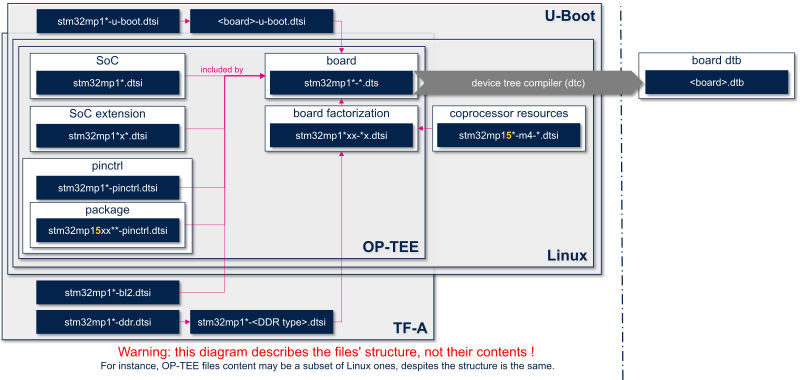This article describes how the device tree files for STM32MPU are organized for Linux®, U-Boot and TF-A but also how they are organized when they are generated from STM32CubeMX.
1. Purpose and scope[edit | edit source]
This article shows the structure of the device tree files as it is implemented in OpenSTLinux for Linux® kernel, U-Boot, TF-A and OP-TEE.
The purpose of this article is not to explain the device tree concept and the device tree configuration supported by STM32MP1 Series. A good knowledge of the concept is a prerequisite before reading this article. The articles regarding the configuration can be read afterwards.
2. Device tree structure[edit | edit source]
The device tree files are used during boot time by the FSBL (TF-A), the secure OS (OP-TEE), the SSBL (U-Boot) and, at run time, by the Linux kernel.
These files are stored in different github repositories (one for each first level bullet below), but source code reuse is maximized from one repository to another:
- The initial device tree files supporting STM32MP1 Series are created in the Linux kernel.
- The source code path is arch/arm/boot/dts/stm32mp1* .
- In U-Boot, Linux files are copied and overloaded with U-Boot properties.
- The source code path is arch/arm/dts/stm32mp1* .
- The U-Boot add-ons file, "<dts-file-name>-u-boot.dtsi", is automatically included at the end of "<board>.dts" during device tree compilation: this is a generic U-Boot Makefile behavior, see binman.rst .
- In TF-A, Linux files are copied, completed with the security configuration (firewalling) and the DDR configuration. TF-A BL2 is applying some 'delete-property' on useless nodes, to lighten the final dtb file.
- The source code path is fdts/stm32mp1* .
- In OP-TEE, Linux files are reused.
- The source code path is core/arch/arm/dts/stm32mp1* .
The figure below shows the device tree files structure for Linux, U-Boot, TF-A and OP-TEE:

3. STM32CubeMX generated device tree[edit | edit source]
STM32CubeMX can help to generate the device tree files for a given project, for the various software components:
- TF-A: STM32CubeMX generates three files:
- 'stm32mp15-mx.dtsi' is equivalent to 'stm32mp1*-<DDR type>.dtsi' in the diagram above, embedding DDR settings
- 'stm32mp1*-<your_project_name>-mx.dts' is the board device tree file, that includes all dtsi files (directly or not)
- 'stm32mp1*-<your_project_name>-mx-fw-config.dts' file corresponds to the TF-A firmware configuration and is out of the file structure shown in the previous paragraph
- U-Boot:
- 'stm32mp1*-<your_project_name>-mx.dts' is the board device tree file, that includes all dtsi files (directly or not)
- 'stm32mp1*-<your_project_name>-mx-u-boot.dts' is equivalent to the '<board>-u-boot.dtsi' file in the diagram above
- Linux:
- 'stm32mp1*-<your_project_name>-mx.dts' is the board device tree file, that includes all dtsi files (directly or not)
- OP-TEE:
- 'stm32mp1*-<your_project_name>-mx.dts' is the board device tree file, that includes all dtsi files (directly or not)
The device tree files generated by STM32CubeMX can be built with the Developer Package or Distribution Package:
- Use the Developer Package to store the STM32CubeMX-generated files in the folder of your choice. Then, manually copy or link them into Linux, U-Boot and TF-A device tree folders (see Device tree structure). Do not forget to add your device tree file name in ../Makefile.sdk (for TF-A SDK and U-Boot SDK) and in arch/arm/boot/dts/Makefile (for Linux kernel SDK), before compiling them as explained in How to cross-compile with the Developer Package.
- Use the Distribution Package to store the STM32CubeMX-generated files in meta-st/meta-st-stm32mp-addons/mx, as explained in the How to create your own machine article. This article also describes how to build the complete image. Examples of Linux (device tree), U-Boot and TF-A individual compiling can be found in the How to cross-compile with the Distribution Package article.